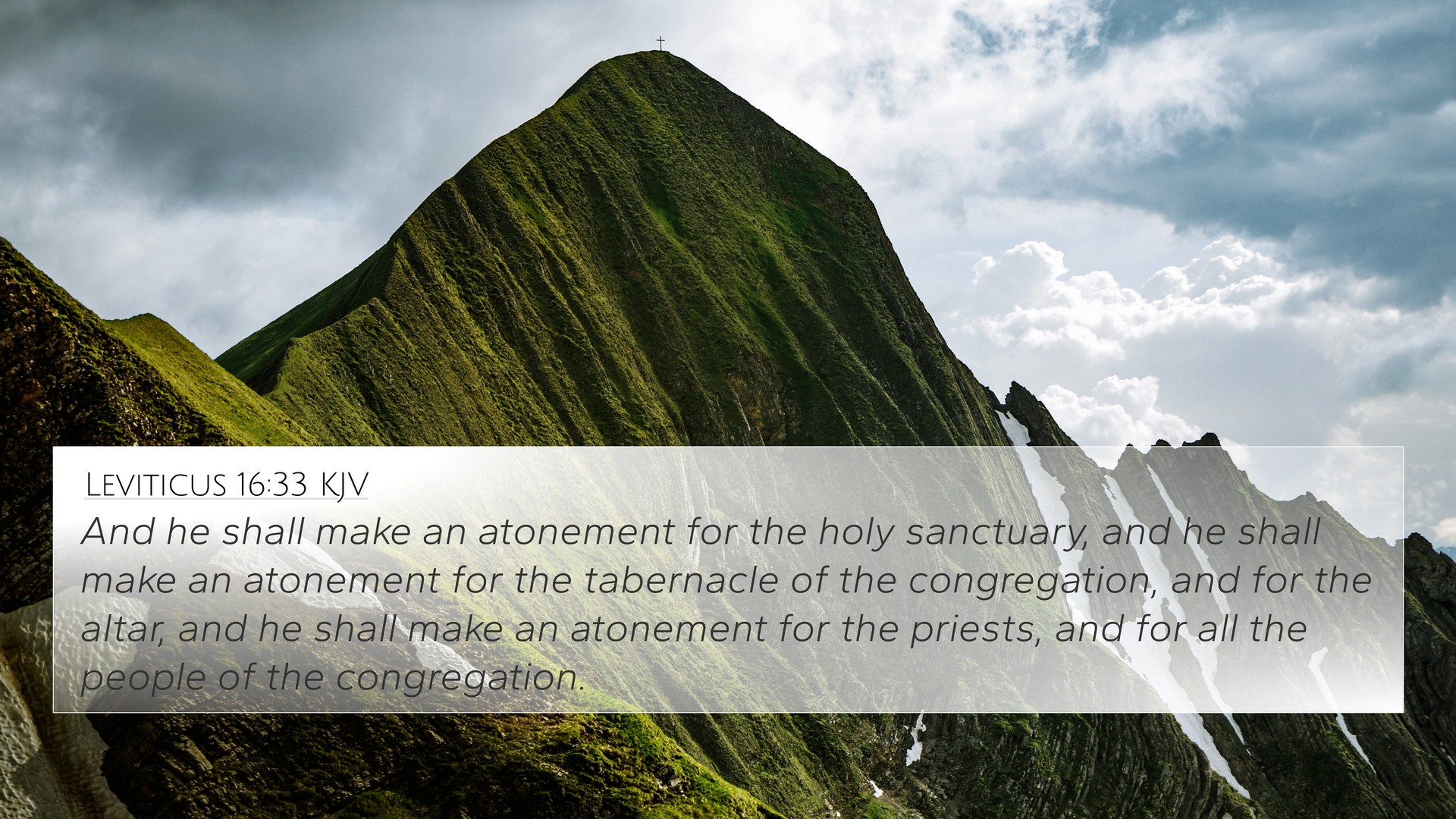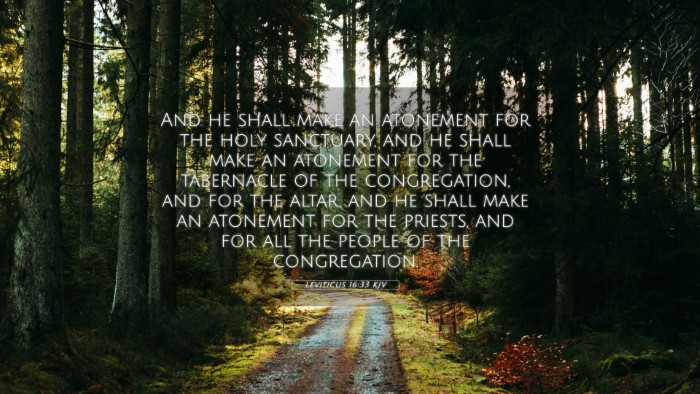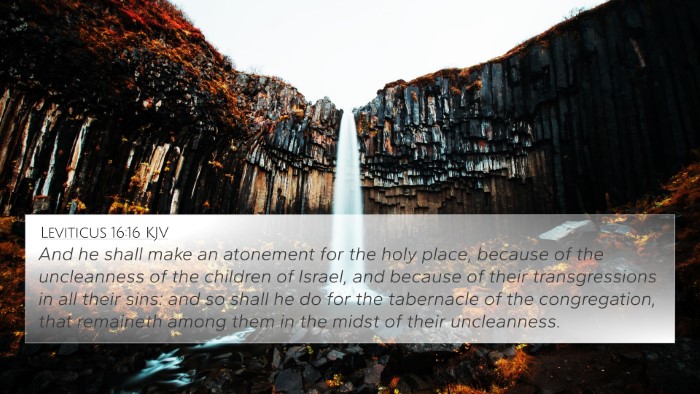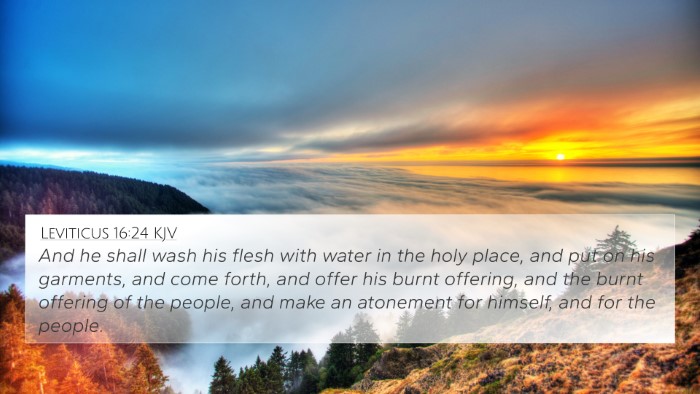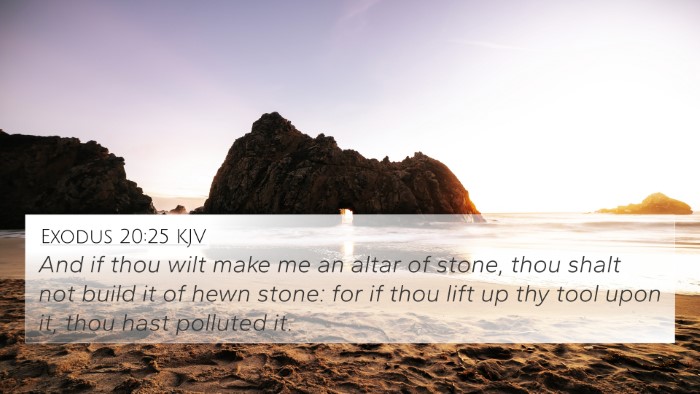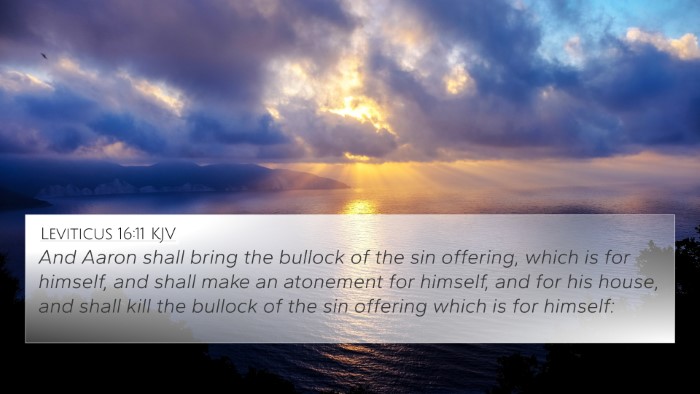Understanding Leviticus 16:33
Verse: Leviticus 16:33 - "And he shall make an atonement for the holy sanctuary, and he shall make an atonement for the tabernacle of the congregation, and for the altar; and he shall make an atonement for the priests, and for all the people of the congregation."
Summary of Meaning
This verse highlights the comprehensive nature of atonement in the Levitical system. The priest's role during the Day of Atonement (Yom Kippur) illustrates the seriousness of sin and the need for a mediator between God and His people. The atonement process serves to cleanse both the physical spaces and the individuals associated with the sanctuary, demonstrating that all aspects of worship must be holy and pure.
Insights from Commentaries
- Matthew Henry: In his commentary, Henry emphasizes the importance of atonement as a means of restoring holiness to the sanctuary and its service. He notes that the atonement acts not only for the physical elements but also for the people, highlighting God's desire for a purified relationship.
- Albert Barnes: Barnes elucidates that this verse speaks to the necessity of purification. He suggests that the act symbolizes the ultimate sacrifice of Christ, who fulfills the need for atonement. His view connects the high priest's duties in the Old Testament to Christ's eternal priesthood, where He makes a perpetual atonement for sin.
- Adam Clarke: Clarke interprets this verse within the broader context of the sacrificial system in the Mosaic Law. He points out that the roles of the priest and the sacrifices made are illustrative of Christ's redemptive work, indicating that the Old Testament practices were shadows of greater spiritual truths to come.
Cross-References
Leviticus 16:33 can be interconnected with several other scripture passages, enhancing our understanding through cross-referencing:
- Hebrews 9:7: Discusses the sacrifices applied for atonement within the Holy of Holies.
- Romans 3:25: Refers to Christ as the propitiation through faith in His blood.
- 1 John 2:2: Portrays Jesus as the atoning sacrifice for our sins, not only for ours but also for the world.
- Leviticus 4:20: Highlights the sin offering and its purpose for making atonement.
- Isaiah 53:5: Foretells the suffering servant who bears our iniquities and brings us peace through His wounds.
- John 1:29: John's declaration of Jesus as the Lamb of God, who takes away the sin of the world.
- Hebrews 10:12: Discusses how Christ, having offered one sacrifice for sins, has perfected forever those who are sanctified.
- Exodus 30:10: Refers to the yearly atonement made by Aaron, tying back to the roles described in Leviticus.
- Ephesians 2:13: Talks about being brought near to God through the blood of Christ, signifying the ultimate fulfillment of atonement.
- Colossians 1:20: Emphasizes the reconciliation through the blood of the cross, connecting to the themes of atonement illustrated in Leviticus.
Thematic Connections
The themes present in Leviticus 16:33 resonate with various biblical motifs, including:
- Holiness: The necessity of maintaining a holy community and sanctified space for God's presence.
- Redemption: The overarching narrative of scripture reflecting God's plan for redeeming humanity through sacrifice.
- Intercession: The vital role of the priest as a mediator between God and the people, foreshadowing Christ's priesthood.
- Forgiveness: The continuous theme of atonement leading to genuine forgiveness of sins.
Comparative Bible Verse Analysis
Analyzing Leviticus 16:33 in conjunction with other verses helps to establish a deeper theological context:
- Consider how Romans 6:23 highlights the cost of sin versus the gift of eternal life through Christ, reinforcing the pity we understand from Leviticus.
- Reflect on Hebrews 10:4, noting that it's impossible for the blood of bulls and goats to take away sins, pointing to the inadequacy of the previous systems.
- Explore Matthew 5:17, where Jesus states that He did not come to abolish the Law but to fulfill it, establishing the continuity between the Old and New Testaments.
- Connect Psalm 51:10-12, where David pleads for a clean heart and spirit, representing the internal need for atonement much echoed in Leviticus.
Tools for Bible Cross-Referencing
To dive deeper into the process of cross-referencing, consider these tools:
- Bible concordances
- Bible cross-reference guides
- Cross-reference Bible study methods
- Bible reference resources like topical Bibles or study Bibles
- Comprehensive Bible cross-reference materials that facilitate deeper study
Conclusion
Leviticus 16:33 serves as a pivotal verse in understanding the sacrificial system laid out in the Old Testament and its ultimate fulfillment in Jesus Christ. Through meaningful cross-referencing and thematic exploration, we can appreciate the intricate links between the Testaments and God's redemptive plan for humanity. As we engage with scripture, the connections between Bible verses reveal the rich tapestry of God's truth, encouraging us to delve deeper into scripture as a living dialogue.
